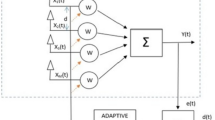Abstract
In this paper we consider OFDM systems with non-contiguous subcarriers where distributed spectrum fragments are applicable for transmission. A new model is proposed for pilot optimization with respect to location and power. The least-square approach is applied for channel estimation at the receiver and the optimization objective is to minimize the mean square error of the channel estimation. This optimization problem is then formulated as minimizing the spread of the eigenvalues of a positive semidefinite matrix, which is a typical semidefinite programming problem, and hence it can be solved with conventional interior-point method. Simulation results show the efficiency of the proposed algorithm.







Similar content being viewed by others
References
Sesia, S., France Issam, T., & Matthew, B. (2009). LTE-the UMTS long term evolution: from theory to practice. New York: Wiley.
Negi, R., & Cioffi, J. (1998). Pilot tone selection for channel estimation in a mobile OFDM system. IEEE Trans. Consum. Electron., 44(3), 1122–1128.
Barhumi, I., Leus, G., & Moonen, M. (2003). Optimal training design for MIMO OFDM systems in mobile wireless channels. IEEE Trans. Signal Process., 51(6), 1615–1624.
Ohno, S., & Giannakis, G. B. (2004). Capacity maximizing MMSE-optimal pilots for wireless OFDM over frequency-selective block Rayleigh-fading channels. IEEE Trans. Inf. Theory, 50(9), 2138–2145.
Hu, D., Yang, Luxi, Shi, Yuhui, & He, Lianghua. (2006). Optimal pilot sequence design for channel estimation in MIMO OFDM systems. IEEE Commun. Lett., 10(1), 1–4.
Song, S., & Singer, A. (2007). Pilot-aided OFDM channel estimation in the presence of the guard band. IEEE Trans. Commun., 55(8), 1459–1465.
Huang, Q., Ghogho, M., & Freear, S. (2009). Pilot design for MIMO OFDM systems with virtual carriers. IEEE Trans. Signal Process., 57(5), 2024–2029.
Qi, C., Yue, G., Wu, L., & Nallanathan, A. (2014). Pilot design for sparse channel estimation in OFDM-based cognitive radio systems. IEEE Trans. Veh. Technol., 63(2), 982–987.
Baxley, R. J., Kleider, J. E., & Zhou, G. T. (2009). Pilot design for OFDM with null edge subcarriers. IEEE Trans. Wirel. Commun., 8(1), 396–405.
Hu, D., He, L., & Wang, X. (2011). An efficient pilot design method for OFDM-based cognitive radio systems. IEEE Trans. Wirel. Commun., 10(4), 1252–1259.
Boyd, S., & Vandenberghe, L. (2004). Convex optimization. Cambridge: Cambridge University Press.
Dai, S., Chen, F., Chen, X., & Xiong, S. (2012). Optimal power allocation of pilot symbols for LS channel estimation in OFDMA uplink. In 2012 IEEE international conference on circuits and systems (ICCAS), pp. 112–115.
Toh, K. C., Ttnc, R. H., & Todd, M. J. (2001). A MATLAB software package for semidefinite-quadratic-linear programming. http://www.math.cmu.edu/~reha/sdpt3.html.
Lawler, E. L., & Wood, D. E. (1966). Branch-and-bound methods: a survey. Oper. Res., 14(4), 699–719.
3GPP TS 36.211 Release 12. (2014, September). Evolved universal terrestrial radio access (E-UTRA); Physical channels and modulation. http://www.3gpp.org/DynaReport/36211.htm.
Gong, M., Chen, F., et al. (2013). Normalized adaptive channel equalizer based on minimal symbol-error-rate. IEEE Trans. Commun., 61(4), 1374–1383.
Sarmadi, N., Shahbazpanahi, S., & Gershman, A. B. (2009). Blind channel estimation in orthogonally coded MIMO-OFDM systems: a semidefinite relaxation approach. IEEE Trans. Signal Process., 57(6), 2354–2364.
Vandenberghey, L., & Boyd, S. (1996). Semidefinite programming. SIAM Rev., 38, 49–95.
Shi, Y., Hou, Y. T., Kompella, S., & Sherali, H. D. (2011). Maximizing capacity in multihop cognitive radio networks under the SINR model. IEEE Trans. Mob. Comput., 10(7), 396–405.
Acknowledgments
This work is supported by the National High-tech program (No. SS2015AA011307), the National Natural Science Foundation of China (Nos. 61171083, 61322108, 61431005, 61372083), the Key Grant Project of Chinese Ministry of Education (No. 313021) and the NCET program (No. NCET-12-0196). Ting Chen: All authors claim that he should be considered co-first author.
Author information
Authors and Affiliations
Corresponding author
Rights and permissions
About this article
Cite this article
Pan, W., Shan, Z., Chen, T. et al. Optimal pilot design for OFDM systems with non-contiguous subcarriers based on semi-definite programming. Telecommun Syst 63, 297–305 (2016). https://doi.org/10.1007/s11235-015-0121-7
Published:
Issue Date:
DOI: https://doi.org/10.1007/s11235-015-0121-7




